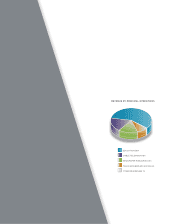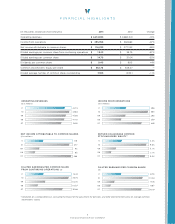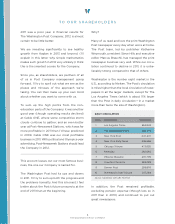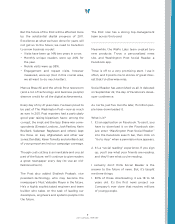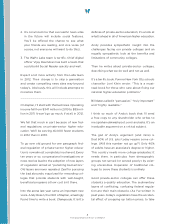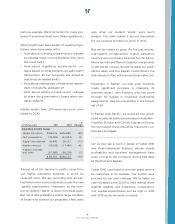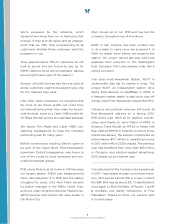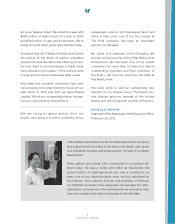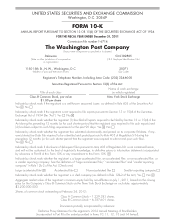Washington Post 2011 Annual Report Download - page 5
Download and view the complete annual report
Please find page 5 of the 2011 Washington Post annual report below. You can navigate through the pages in the report by either clicking on the pages listed below, or by using the keyword search tool below to find specific information within the annual report.
3
2011 ANNUAL REPORT
But the future of the Post will be aected more
by the substantial digital progress of 2011.
Excellence at what we have done for years will
not get us to the future; we need to transition
to a new business model:
• Visitshavebeenup14%twoyearsinarow.
• Monthly unique readers were up 26% for
the year.
• Mobilevisitswereup98%.
• Engagement and repeat visits, however
measured, were up (but in this crucial area,
we all want to do much better).
Marcus Brauchli and the whole Post newsroom
(and a lot of technology and business people)
deserve credit for all the digital achievements.
Every day of my 41 years here, I’ve been proud to
be part of The Washington Post — now as much
as ever. In 2011, Post reporters had a particularly
good year raising bipartisan havoc among the
corrupt, the inept and the lazy. Brave war corre-
spondents (Ernesto Londono, Josh Partlow, Karin
Brulliard, Sudarsan Raghavan and others) kept
the focus on Iraq, Afghanistan and other war
zones; Dan Balz, Karen Tumulty and a brilliant cast
of young reporters led our campaign coverage.
Though cost-cutting is an inevitable and crucial
part of the future, we’ll continue to give readers
a great newspaper every day (to use an old-
fashioned term).
The Post also added Shailesh Prakash, vice
president–technology, who may become the
newspaper’sMostValuablePlayerinthefuture.
He’s a highly sophisticated engineer and team
builder who takes on the task of leading our
developers, engineers and systems people into
the future.
The Post now has a strong top-management
team across the board.
Meanwhile, the WaPo Labs team created two
new products: Trove, a personalized news
site, and Washington Post Social Reader, a
Facebook app.
Trove is o to a very promising start. I use it
often, and it points me to stories of great inter-
est that I’d otherwise miss.
Social Reader has astonished us all. It debuted
on September 22, the day of Facebook’s devel-
oper conference.
As I write, just five months later, 15 million peo-
ple have downloaded it.
What is it?
1. It’s an application on Facebook. To use it, you
have to download it on the Facebook site:
just enter “Washington Post Social Reader”
into the Facebook search bar, then click on
“Go to App” when a permission box appears.
2. It’s a “social reading” experience. If you sign
up, you’ll see what your friends are reading,
and they’ll see what you’re reading.
I certainly don’t think Social Reader is the
answer to the future of news. But, it’s taught
me three things:
1. 80% of those downloading it are 18 to 34
years old. It’s the first news project our
Company’s ever done that reaches millions
of young people.


